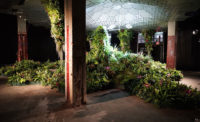A plan by Rafael Viñoly to transform New York’s former Domino sugar refinery into homes, offices, and shops has cleared a major regulatory hurdle, even if a few tweaks are required.

On Monday, June 7, the city’s planning commission voted 13-0 to approve the $1.5 billion New Domino proposal, which calls for adding 2,200 apartments to a five-block esplanade in Brooklyn, near the Williamsburg Bridge. About a third of the apartments, or 660, would be affordable.
While most of the old buildings now standing on the 11.2-acre site would be razed, Viñoly’s plan preserves a smokestack-topped brick structure that dates to 1884.
The massive project, which is being jointly developed by CPC Resources, a subsidiary of the not-for-profit Community Preservation Corporation, and the Katan Group, a local builder, now heads to a final vote before City Council, which must consider it within two months.
“This project will bring high-quality design and architecture, ample public open space, significant community facilities, and much needed housing, both market rate and affordable, to the Williamsburg community,” said planning commission chair Amanda Burden, in a statement.
But the plan’s design, which also involves Beyer Blinder Belle Architects and Planners and Quennell Rothschild & Partners, did not escape unscathed.
The planning commission insisted developers shrink three office towers in the full-block complex at the site’s northernmost edge by between 15 percent and 35 percent, so they don’t cast shadows over the tiny Grand Ferry Park located next door.
Because that reduction could result in less rentable commercial space, “it’s not what we hoped would happen,” Susan Pollock, a vice president with CPC Resources, told RECORD. But in general, she was “jubilant” with the outcome of the vote.
Also, there won’t be as many parking spaces as first sought, as the permitted amount must decrease from 1,692 to 1,498. Space also must be allocated for an onsite grade school.
Still, whether New Domino can pass the council is unclear. In March, Williamsburg’s community board, an advisory group, rejected the plan 23-12, and there continues to be concerns about scale as well as transportation to and from the site, which is 10 blocks from the subway.
But architect Martin Hopp of Rafael Viñoly Architects, who’s the project’s director, is hopeful that council members will come around. “It’s clear a fight will take place,” he says. But affordable housing “and open space that’s double what’s required under the zoning, are the project’s real merits.”


Post a comment to this article
Report Abusive Comment